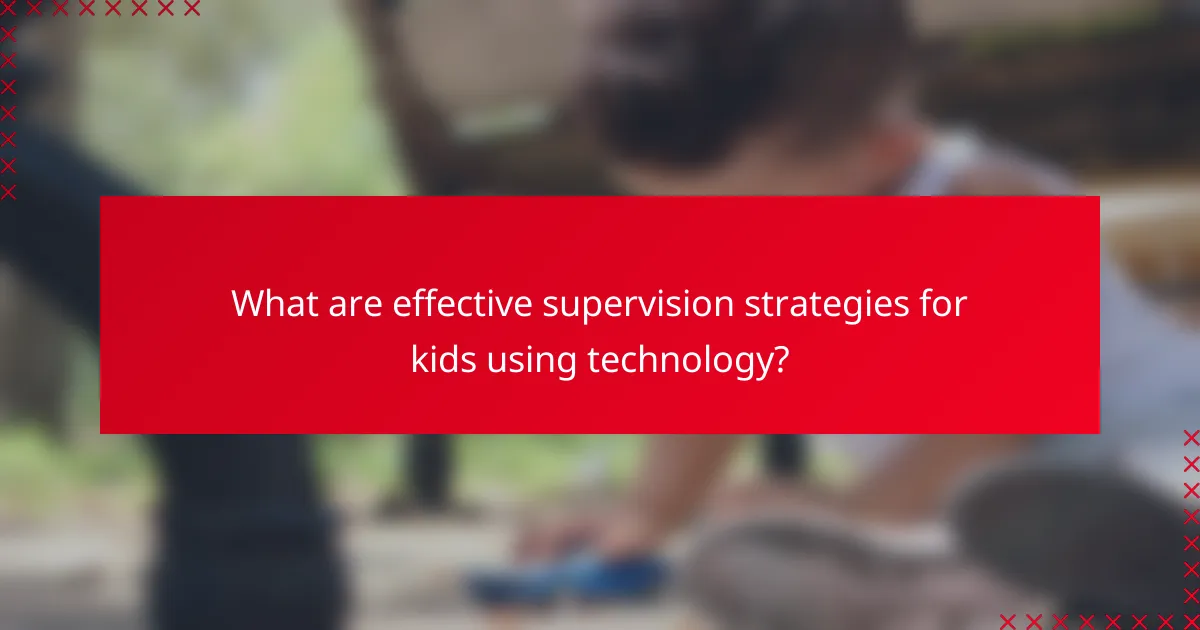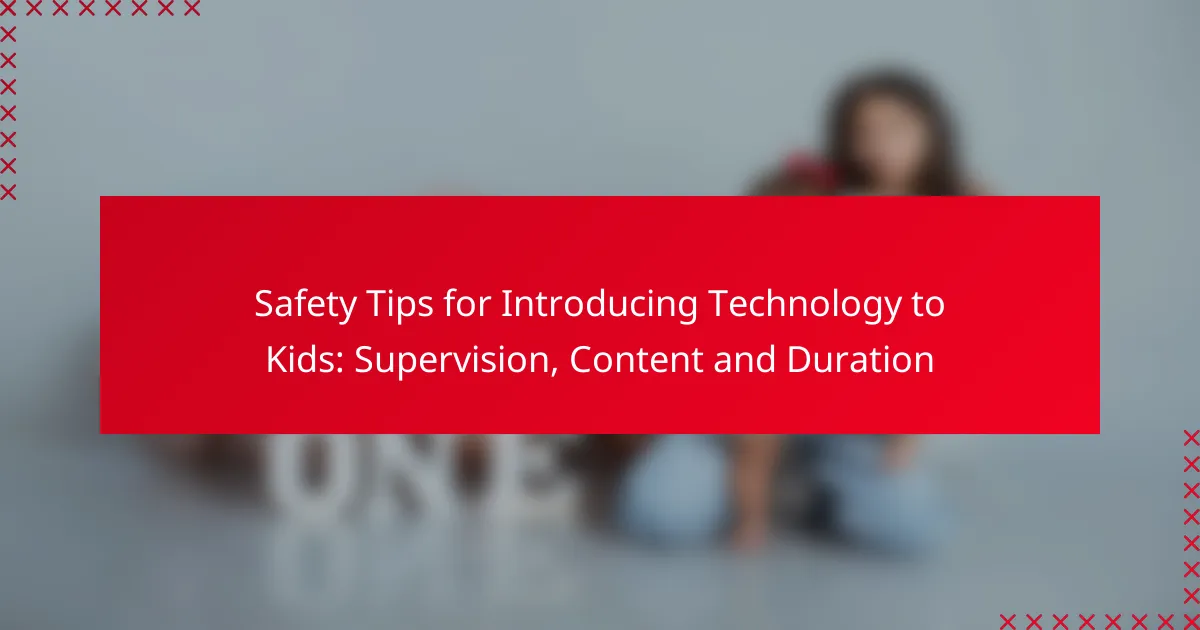Introducing technology to kids requires careful consideration of supervision, content, and duration to ensure a safe and enriching experience. Effective supervision strategies, such as active monitoring and co-viewing, help foster responsible use while appropriate content promotes learning without exposing children to harmful themes. Additionally, managing screen time is essential for healthy development, encouraging a balanced approach to technology use.

What are effective supervision strategies for kids using technology?
Effective supervision strategies for kids using technology include active monitoring, setting clear boundaries, and engaging in co-viewing experiences. These approaches help ensure that children use technology safely and responsibly while fostering healthy habits.
Active monitoring of screen time
Active monitoring involves keeping a close eye on how much time children spend on devices and what activities they engage in. Parents can set specific time limits, such as one to two hours per day, depending on the child’s age and needs. Regularly checking in on their activities helps identify any inappropriate content or excessive usage.
Consider using apps or built-in device features to track screen time. This can provide insights into usage patterns and help adjust limits as necessary, ensuring a balanced approach to technology consumption.
Setting clear usage boundaries
Establishing clear usage boundaries is crucial for guiding children’s technology habits. Define specific times for device use, such as no screens during meals or before bedtime. This helps create a routine that prioritizes face-to-face interactions and sleep hygiene.
Communicate these rules clearly to your child and involve them in the process. This can foster a sense of responsibility and understanding regarding the importance of balanced technology use.
Engaging in co-viewing experiences
Co-viewing experiences involve watching shows, playing games, or using apps together with your child. This not only allows you to monitor content but also provides opportunities for discussion about what they are seeing or doing. Engaging together can enhance understanding and critical thinking about media.
Ask open-ended questions during these activities to encourage dialogue. This interaction can help children develop media literacy skills and make informed choices about their technology use.
Utilizing parental control tools
Parental control tools can help manage and restrict access to certain content, apps, or websites. Many devices and platforms offer built-in parental controls that allow you to set age-appropriate restrictions. Familiarize yourself with these features to customize settings according to your child’s age and maturity level.
Regularly review and adjust these controls as your child grows and their needs change. This proactive approach ensures that they are protected from harmful content while still enjoying the benefits of technology.
Establishing open communication
Open communication about technology use is essential for fostering a safe environment. Encourage your child to share their online experiences, including any concerns or uncomfortable situations they may encounter. This dialogue builds trust and helps them feel comfortable approaching you with issues.
Set aside time for regular discussions about internet safety, privacy, and the importance of respectful online behavior. This ongoing conversation can empower children to navigate technology responsibly and confidently.

What content is appropriate for children?
Appropriate content for children includes educational materials that are engaging, age-appropriate, and safe. It is crucial to select resources that promote learning while ensuring they are free from harmful or inappropriate themes.
Age-appropriate educational apps
When choosing educational apps for children, consider their age and developmental stage. Apps designed for preschoolers often focus on basic skills like counting and letter recognition, while those for older children may introduce more complex subjects like math or science.
Look for apps that have been reviewed positively by educators and parents. Popular examples include “Endless Alphabet” for younger kids and “Khan Academy Kids” for a broader age range. Always check for age ratings and user reviews before downloading.
Safe online platforms for kids
Safe online platforms for kids provide a controlled environment for learning and entertainment. Websites like PBS Kids and National Geographic Kids offer educational games and videos that are suitable for various age groups.
Ensure that any platform you choose has robust privacy policies and parental controls. This helps protect your child’s personal information and allows you to monitor their online activity effectively.
Recommended video content for children
Recommended video content for children should be both educational and entertaining. Shows like “Sesame Street” and “Bluey” are excellent choices as they combine fun with valuable lessons about social skills and problem-solving.
When selecting videos, consider platforms like YouTube Kids, which curates content specifically for younger audiences. Always preview videos to ensure they align with your values and are appropriate for your child’s age.
Filtering harmful content
Filtering harmful content is essential for protecting children from inappropriate material online. Utilize parental control tools available on devices and apps to restrict access to unsuitable websites and content.
Establish guidelines for internet use, such as setting time limits and discussing what types of content are acceptable. Regularly review your child’s online activity to ensure compliance with these guidelines and to foster open communication about their digital experiences.

How long should kids use technology daily?
Kids should ideally use technology for a limited time each day, with recommendations varying by age. Balancing screen time with other activities is crucial for healthy development.
Guidelines from pediatric associations
Pediatric associations, such as the American Academy of Pediatrics (AAP), suggest that children aged 2 to 5 should have no more than one hour of high-quality programming each day. For children under 18 months, they recommend avoiding screen time altogether, except for video chatting.
These guidelines emphasize the importance of parental involvement in media consumption, encouraging caregivers to co-view and discuss content with their children to enhance understanding and engagement.
Age-based screen time recommendations
Screen time recommendations vary significantly based on age. For preschoolers (ages 2-5), one hour of supervised screen time is suggested, while children aged 6 and older should have consistent limits that ensure time for physical activity and sleep.
For teenagers, balancing technology use with responsibilities and social interactions is essential. Encouraging them to set boundaries can help manage their screen time effectively.
Balancing technology with physical activity
It is vital to balance technology use with physical activity to promote overall health. Experts recommend that children engage in at least one hour of moderate to vigorous physical activity each day, which can help counteract the sedentary nature of screen time.
Parents can encourage active play by incorporating technology in a way that promotes movement, such as using fitness apps or interactive video games that require physical participation. This approach helps children enjoy technology while staying active and healthy.

What are the risks of excessive technology use?
Excessive technology use can lead to various risks, including physical health issues, mental well-being concerns, and challenges in developing social skills. Understanding these risks helps caregivers make informed decisions about technology exposure for children.
Impact on physical health
Excessive screen time can contribute to a range of physical health problems in children, such as obesity, poor posture, and eye strain. The American Academy of Pediatrics suggests limiting recreational screen time to about one hour per day for children aged 2 to 5 years.
Encouraging regular physical activity is crucial. Parents can set a routine that includes outdoor play or sports, aiming for at least 60 minutes of active play each day to counterbalance technology use.
Effects on mental well-being
High levels of technology use can negatively impact children’s mental health, leading to issues such as anxiety, depression, and reduced attention spans. Studies indicate that children who spend more time on screens may experience lower levels of happiness and life satisfaction.
To mitigate these effects, parents should monitor content quality and promote a balanced lifestyle that includes offline activities. Engaging in family discussions about feelings and experiences related to technology can also foster emotional resilience.
Social skills development challenges
Excessive technology use can hinder the development of essential social skills in children, such as effective communication and empathy. Face-to-face interactions are crucial for learning social cues, and too much screen time can limit these opportunities.
Encouraging children to participate in group activities, such as team sports or clubs, can help them practice social skills in real-life situations. Setting aside technology-free family time can also promote stronger interpersonal relationships and communication skills.
